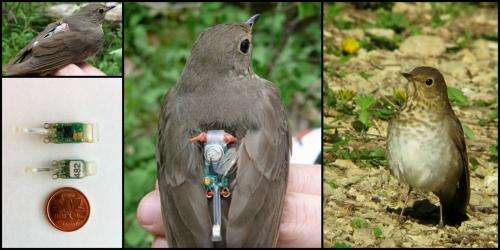Mixed genes mix up the migrations of hybrid birds

Mixed genes appear to drive hybrid birds to select more difficult routes than their parent species, according to new research from University of British Columbia zoologists.
"Instead of taking well-trodden paths through fertile areas, these birds choose to scale mountains and cross deserts," says UBC researcher Kira Delmore.
Delmore harnessed a flock of Canadian Swainson's thrushes with tiny geolocating backpacks to map their routes as they migrated south through the U.S. to Central and South America.
Many of the hybrid thrushes chose intermediary migration routes situated between the paths of their parent populations, regardless of how challenging the route may be. It's the first time researchers have gathered detailed data mapping the routes of free-flying hybrids and their parent populations.
"The association between mixed genetic background and mixed migratory routes implies that there is strong genetic control of migratory behaviour," says Darren Irwin, a professor in UBC's Dept. of Zoology and senior author of the study. "These thrushes will allow us to actually look for the genes responsible for migratory behaviour."
In many cases, hybridization can cause populations that are separated to collapse into a single form.
"In this case, where hybrids might well be surviving at lower rates, this may not happen," says Delmore. "The self-destructive behavior of hybrids could be helping to maintain the great diversity of songbirds we enjoy."
Background
Researcher Kira Delmore attached geolocation devices – which record sunrise and sunset times – on the birds with harnesses. She collected the data a year later, downloading the information and inferring latitude and longitude from the recorded sunrise and sunset times.
Swainson's thrushes – with olive-brown feathers, lighter mottled undersides, and distinct light eye-rings – are typically 16 to 20 centimetres in length with a wingspan of 30 cm. They are not endangered. The geolocators weighed 0.9 g with attachment materials, approximately 4 per cent of the body weight of a thrush.
More information: "Hybrid songbirds employ intermediate routes in a migratory divide." Kira E. Delmore and Darren E. Irwin. Ecology Letters (2014) DOI: 10.1111/ele.12326
Journal information: Ecology Letters
Provided by University of British Columbia


















